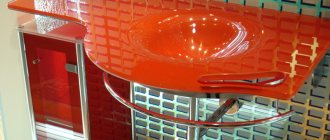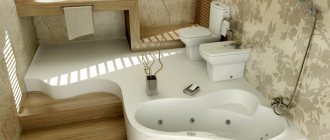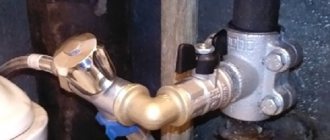The equipment of most bathrooms in apartment buildings and individual residential buildings includes a specially shaped heat exchanger that performs the functions of a heated towel rail. The bathroom coil can have different designs; it is connected to the hot water supply line in order to maintain the device in a constantly heated state.
The coil models on the market differ from each other not only in design, but also in the methods of heating the heat exchange device. When placing a device with your own hands in the bathroom, you will need knowledge about the models produced, the materials used to make them, and installation features.
U-shaped and M-shaped coils
Functionality. Application
Coil
The relevance and prevalence of the coil has increased quite recently and has rapidly captured the domestic market of plumbing fixtures. The remarkable efficiency of the heating element is justified by its compactness and heating efficiency. Bulky, heavy radiators are extremely impractical in a small bathroom. The following functional features of the coils ensure the popularity of the device.
The relevance of coils is justified by the increased humidity, which, in turn, provokes the development of mold. Modern lines of snake-like dryers have acquired new forms: ladder, drop.
Equipment dimensions
This equipment should effectively dry the air and create a comfortable temperature in the room. It is necessary to carefully calculate the required dimensions of the heated towel rail for the bathroom. The power of the structure depends on this indicator.
Users who do not know how to install a heated towel rail in the bathroom that can efficiently perform practical functions need to look at special tables. They determine the dimensions of the product, which are suitable for a room with a certain area. For example, for a room of 6-8 m2 you need a heated towel rail for a bathroom measuring 60x60 cm.
The required power of a heated towel rail depends on the size of the bathroom
When choosing a model, you need to focus not only on the dimensions of the structure. If the structure will be installed in an existing heating system, you should correctly select the connecting dimensions of the heated towel rail for the bathroom. In the range of manufacturers you can choose models with diameters (in mm):
- 19,
- 25,
- 32,
- 40.
All coil shapes are available only in the most common size with an outer diameter of 32 mm. In other categories, you can only select certain types of structures. In order to install a heated towel rail in the bathroom without any problems, you need to choose it taking into account the specifics of communication.
Choose a heated towel rail taking into account the specifics of communications
Counteracting biological organisms
Conditions of high humidity inevitably provoke the formation of condensation, which, in turn, becomes an ideal environment for the development of fungi and mold. If you ignore the recommendations of specialists and do not clean the wall covering from condensation in a timely manner, a destructive effect is inevitable. Deformed walls, mold formation and the risk of infectious development. In addition, in damp conditions, a snake-like heater is an indispensable device in the bathroom.
Main functions
Coils are a useful thing, and they have four main advantages, which, in fact, are why they are so widespread in houses, apartments and even public toilets.
- Provides high-quality heating to the plumbing room.
- Do not allow mold, dampness, or fungus to form in the room.
- Quite often used as a means for drying clothes or even warming towels when you get out of the shower or bath.
- They add sophistication to the interior as some coil models look really cool. This is especially true for models with chrome plated.
Distribution of coils: types
The domestic and foreign market is filled with a sufficient number of heating coils. The main types of devices are:
- Water type heating. Coils mainly work in the cold season, as they are integrated into the central heating system.
- Electric type. The coil filler is oil or water. The advantage of the heater remains the ability to activate heating at any time.
- Combined type. Includes integration into the central heating system, as well as equipping with a fuel element. Of course, you can use it in the cold season.
Note: the cost of combined heated towel rails is significantly higher.
Before purchasing a coil, it is recommended that you familiarize yourself with the key features of your choice:
- During operation, it is necessary to pay attention to the pressure indicator in the central heating system. Otherwise, there is a danger of destruction of the coil structure with further failure.
- A special instruction table is supplied with any coil, which contains recommended heat output values.
Water coil
Water coil
The most common coil heater relevant on the market remains the water type. This is justified, first of all, by the market value of the device. The coil is directly connected to the central heating system, which means that during the warmer months the heater will not operate. It is noteworthy that the presence of autonomous heating in the house will allow you to judiciously use the heating capabilities of the apartment. The coil is heated by intensive circulation of hot water in the pipes.
However, a negative point in the operation of water coils remains the risk of pipe clogging. The most common root causes of this are:
- Water quality. Low-quality water in the heating system inevitably leads to clogged pipes.
- Presence of scale. In this case, third-party objects lead to disruption of water circulation.
- Air. So-called air locks require regular cleaning of the coil. It is noteworthy that for this it is better to use the services of a specialist.
Note: the durability of the coils is quite indicative: the average service life of a coil heater is from 7 to 8 years.
An additional and significant problem in the operation of a water-type coil will be the danger of complete clogging, which requires a comprehensive replacement of the coil.
Electric coil
Electric coil
The classic heating option in a modern bathroom remains the electric coil. The advantageous aspect of this type of coil remains autonomy in operation and practicality in installation. So, regardless of the location of the heating communication, only a socket is required for the operation of an electrical appliance. Water or high-quality oil is used as filler for the electric coil. After activating the device, the coil will reach the desired temperature in a short time.
It is noteworthy that the amount of electricity consumed does not exceed 100 W per month. Consequently, complex heating of a bathroom will cost a month of using a regular 100 W lighting lamp.
However, before purchasing a device, be sure to study the indicated power, as well as the presence of a temperature control toggle switch. It is better to entrust the installation of the coil to a professional, since the bathroom is an environment of high humidity, where the conductivity of electricity is slightly increased.
Combined coil
The prerogative of this type of heater remains the possibility of universal use of the coil both in summer and during the heating season. In this way, the accumulation of excess moisture during the transition period can be avoided.
The ergonomics of the coil are obvious - energy savings during the heating season. However, the market value of the heater significantly exceeds the cost of analogues. In addition, the installation process requires the intervention of a specialist due to the fact that the coil needs to be connected to the central heating system. Also, you need to make sure that there is an additional power source - an outlet.
The correct location of the heater is fraught with practicality and ease of use.
The best Russian and foreign manufacturers
The heated towel rail market is diverse: you can find models of any quality, design, price, so you should pay special attention to the brand and reputation of the manufacturer. Let's consider which electric heated towel rails our compatriots consider the best.
The Italian company Margaroli produces models with power from 100 to 300 W. All of them are distinguished by a thoughtful design and increased comfort in operation.
Best manufacturers:
- Kermi. Kermi heated towel rails are truly German quality and Swiss reliability. The Kermi brand has been known on the market for more than half a century and is already considered legendary. The main advantage of this brand’s equipment is its reasonable price-quality ratio. Heated towel rails are made of good steel, mainly in the shape of a ladder. They are durable, reliable, and stylistically neutral.
- Arbonia. Designer radiators and heated towel rails from the Swiss company Arbonia are an expensive pleasure, but the quality and appearance of the products are beyond praise. Models are made of steel. Antifreeze is used as a coolant for combined heated towel rails. It is possible to manually adjust the heating temperature.
- Margaroli . Italian appliances from the Margaroli brand are not affordable for everyone. Heated towel rails of this brand are made of high-quality expensive materials and equipped with automatic equipment. There are devices made of brass. Distinctive features of Margaroli equipment are exquisite design and durability. The manufacturer is so confident in the quality of the product that it provides a 15-year guarantee.
- Energy . Energy Group is one of the leaders in the European heating equipment market. The manufacturer produces durable, high-quality devices. Any design: the range includes flat, three-dimensional, rotary models of various configurations. The Energy U G3K heated towel rail is especially popular because... combines good technical characteristics and reasonable price.
- "Sunerja". The Russian company produces elite models of heated towel rails, which are in demand not only in the domestic but also in the European market. The models are varied in design, made of stainless steel with a durable shiny coating. The warranty for Sunerge products is 5 years.
- "Dvin". The Russian company has produced more than 30 series of heated towel rails made of polished stainless steel. Most of the models are made in the form of a ladder. The manufacturer provides a 1 year warranty on its products.
- "Nika". Electric heated towel rails of the Nika brand have been known on the market for more than 10 years. Buyers value branded products for their good quality and stylish design. The company does not produce rotating models, but there are many interesting heated towel rails with shelves. The warranty on this company's products is 5 years.
- Terminus. The main advantage of heated towel rails of the Russian brand Terminus is a wide selection of models. Among them there are both budget and expensive ones. The heated towel rails are made of 2 mm thick steel. The models are distinguished by high performance characteristics and stylish design. The manufacturer provides a 10-year warranty.
- "Leader-Steel". Many buyers prefer products. The heated towel rails are made of stainless steel, the heating temperature can be adjusted from 30 to 70 degrees. In case of overheating or hypothermia, the devices turn off automatically. The manufacturer provides a 5-year warranty.
- Terma . The Polish company Terma has been known on the market for more than a quarter of a century. During this time, it gained popularity among our compatriots.
Terma heated towel rails are made of high quality steel and equipped with thermostats.
A number of manufacturers produce, in addition to electric, water and combined models.
Terminus brand models are made in Russia: the manufacturer uses high-quality imported materials, in particular Italian stainless steel
Features of choice. Device material
Stainless steel coil
The features of the heating process are quite similar, although the material of the coils is significantly different.
The domestic market is filled with heaters consisting of the following materials:
- Stainless steel. The most versatile, durable and practical option. However, stainless steel is extremely labile to low-quality heating water. High-quality coils are predominantly coated with durable paint materials such as chrome, waterproof compounds and polish. By the way, painted coils are cheaper, however, the paint coating quickly becomes unusable.
- Dark steel. The so-called black steel is in most cases covered with an additional protective layer. The inner walls of the coil contain a comprehensive anti-corrosion coating, which prevents early malfunction of the device.
- Non-ferrous materials – metals. The prerogative in this type of materials is brass and copper, which are characterized by a high degree of heat transfer. However, a limited service life negatively affects the popularity of the product on the market. Coils on non-ferrous metal are characterized by aesthetic beauty.
Note: Do not under any circumstances purchase a coil that is low in cost. Most likely, the heater uses fake or low-quality stainless steel.
No water - no heat
The fifth significant drawback is interruptions in the supply of hot water. They occur at least once a year, but in practice this happens much more often.
Even if you have a private house with a gas heating boiler, then there is no point in having a water heated towel rail. Few people would think of running a boiler in the summer because of one small coil. It is cheaper to adapt a boiler for this purpose.
The sixth problem, on the contrary, is related to not turning off the water. If in the summer heat the hot water is not turned off, and your coil has a decent area and is connected directly without valves, such a thing can raise the temperature in a small bathroom over 40 degrees!
On the contrary, we will have to wrap up the pipes and somehow plug up this extra heat source.
Seventh, periodic water outages, in addition to inconvenience, lead to more serious consequences. The metal from which the heated towel rail is made heats up and contracts depending on its temperature.
The same thing happens with all threaded connections. And the more often your hot water is turned off, the sooner you expect a leak.
And if you have metal-polypropylene joints, then due to different expansion coefficients, you will see a leak even earlier.
In addition, models of complex shapes have a large number of welds. And they are also a potential site of damage.
Acquisition relevance pledge
When choosing a quality coil, pay attention to the following parameters:
- Features of the bathroom. It is worth considering the fact of accessibility and proximity of heating communications, as well as a source of electricity.
- Heating coil material. Rely on the material's anti-corrosion properties as well as its durable ability to resist chemical additives in your heating water.
- The size of the heating coil plays a priority role in the installation process. An oversized device will most likely place additional stress on the wall covering. In addition, the diameter of the central heating system pipes should be taken into account.
- Bathroom style. The domestic market contains a huge number of different coils, differing in color, material and design features.
- Availability of technical documentation. Be sure to request the coil's passport.
Choosing a high-quality and efficient heating coil will provide your bathroom with a comfortable air temperature.
Varieties
There are two main types of heated towel rails:
- water
- electric
There are also combined ones, but they are used very rarely and, for the most part, due to their cost, are not particularly in demand in our market.
The tasks for both models are the same:
- Direct purpose is drying towels or other linen
- secondary - a heating radiator for a small room to create a comfortable temperature and coziness
If you don’t have a heated floor in your bathroom, then it’s not very pleasant in the winter to bring in a fan heater every time before taking a bath in order to raise the temperature to an acceptable level, and not get goosebumps.
- they also help prevent mirror fogging and condensation accumulation
A good heated towel rail should cope with all three of the above tasks.
Current rules for installing a coil
If you install the heating coil yourself, make sure you have the following set of tools:
- A powerful hammer drill or a modern impact drill.
- Screwdriver.
- Fastening elements.
- Construction ruler and level for measuring indicators.
To connect the central heating system and the coil you will need a high-quality coupling. However, the negative aspect of using a classic coupling is the impossibility of quick dismantling. Purchasing “American women” will allow you to instantly install or remove the connecting element.
Electric heating coils remain the simplest and most practical to install, requiring only installation and direct connection to the electrical network. It is noteworthy that if you are replacing a pre-existing coil, you can use the old fasteners. As a source of electricity, it is worth taking care to completely protect the outlet from moisture. The bathroom is an environment of high electrical conductivity.
Connecting an electric heated towel rail
A very important point for electric models is the correct connection to the 220V network. They should only “sit down” on the line with the RCD and be sure to be grounded.
Grounding in most models is connected in the same place as the power wires.
This does not spoil the appearance and design, but at the same time provides protection.
For this reason, make sure that the plug and socket have the appropriate grounding contacts.
Even if a washing machine produces an electric current, what can we say about a metal thing with an electric cable or heating element running inside it.
In the event of an insulation breakdown and the absence of normal differential protection with a grounding loop, it will be a potential killer, patiently waiting for the moment when you deign to throw a damp towel over it with wet hands.
By the way, grounding pipes is a prerequisite for plumbing devices. Firstly, it helps against corrosion. Secondly, a water coil, just like a water tap, can give you an electric shock, even if the leak is not in your apartment, but in your neighbors.
Read more about this in the article below.
Installing a coil - video
A significant problem when installing combined or water coils remains the need for connection to the heating system. However, the pressure indicator should be taken into account, since a change in pressure can cause damage to the coil from the inside. Pay attention to the connection parameters used in the coils:
- 19 millimeters. Used in a modern type heater - staircase.
- 25 millimeters. Coils P, M-like shape.
- 32 millimeters. The most common diameter of coil pipes.
- 40 millimeters. Used in arc heaters and foxtrots.
The coil installation process is as follows:
- Blocking the central water pipe. Removing the old coil, if present.
- Carefully assemble the structure using the included instructions.
- The coil is leaned against the wall covering, and the spot locations for installing fasteners are marked.
- Using a hammer drill, holes are made in the designated areas. Screwdrivers are installed in the required places.
- The final stage is the most difficult. So, it is necessary to install connecting pipes, as well as make taps, if required. One way or another, the installation process requires the assistance of a qualified specialist.
Note: installation of a combined type heating coil requires an additional electrical connection.
A heating coil is a versatile and practical way to provide your bathroom with the right degree of comfort and genuine convenience.
Form
The bathroom coil produced by a number of manufacturers has a standard pipe diameter of 32 mm and is distinguished primarily by a variety of shapes, the main of which are:
C-shaped , the simplest design of coils installed everywhere during the Soviet era, have low cost and the lowest heat transfer among other types due to the insufficiently high total surface area. Low-cost steel coils with a galvanized surface, designed for side connection, are P (C) or U-shaped.
M-shaped coils with a more complex shape and high thermal output are convenient to use due to the larger number of sections and are designed for side insertion into the pipeline.
Coils of complex shape
Double-circuit coils (S-M, S-C, C-E-shaped) are a popular design of heated towel rails, consisting of two circuits connected in parallel to each other, usually an M, C, E-shaped coil is placed inside a C-shaped coil. The design has high thermal output and an aesthetic appearance, representing a circuit filled with pipelines.
S-shaped , a not so common type of coil, designed for diagonal connection to a hot water supply pipeline.
E-shaped multi-section, unlike previous models, have a greater number of bends, which increases the total surface area and heat transfer efficiency, allowing for efficient heating of large bathrooms, and are designed for side connection.
Ladders are multi-component heated towel rails with a horizontal arrangement of tubular heating elements welded to two large-diameter side posts. Can be connected from the bottom, side or diagonally.
Ladder type heated towel rails











